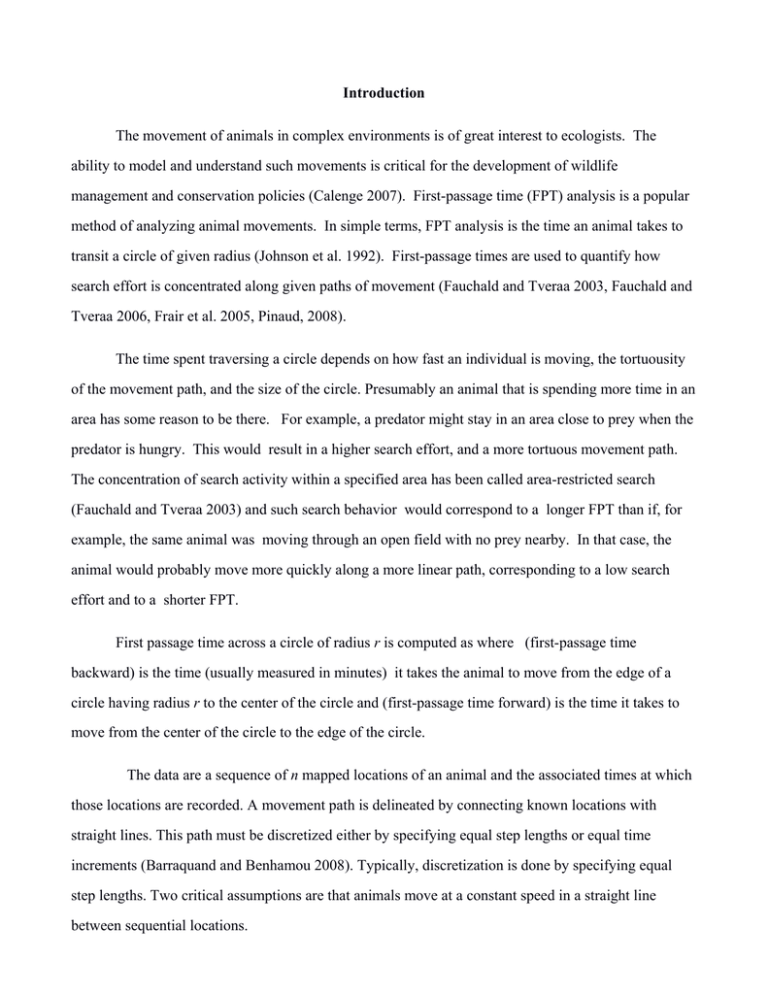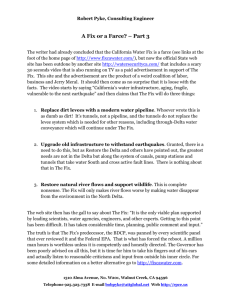Introduction The movement of animals in complex environments is of great... ability to model and understand such movements is critical for...
advertisement

Introduction The movement of animals in complex environments is of great interest to ecologists. The ability to model and understand such movements is critical for the development of wildlife management and conservation policies (Calenge 2007). First-passage time (FPT) analysis is a popular method of analyzing animal movements. In simple terms, FPT analysis is the time an animal takes to transit a circle of given radius (Johnson et al. 1992). First-passage times are used to quantify how search effort is concentrated along given paths of movement (Fauchald and Tveraa 2003, Fauchald and Tveraa 2006, Frair et al. 2005, Pinaud, 2008). The time spent traversing a circle depends on how fast an individual is moving, the tortuousity of the movement path, and the size of the circle. Presumably an animal that is spending more time in an area has some reason to be there. For example, a predator might stay in an area close to prey when the predator is hungry. This would result in a higher search effort, and a more tortuous movement path. The concentration of search activity within a specified area has been called area-restricted search (Fauchald and Tveraa 2003) and such search behavior would correspond to a longer FPT than if, for example, the same animal was moving through an open field with no prey nearby. In that case, the animal would probably move more quickly along a more linear path, corresponding to a low search effort and to a shorter FPT. First passage time across a circle of radius r is computed as where (first-passage time backward) is the time (usually measured in minutes) it takes the animal to move from the edge of a circle having radius r to the center of the circle and (first-passage time forward) is the time it takes to move from the center of the circle to the edge of the circle. The data are a sequence of n mapped locations of an animal and the associated times at which those locations are recorded. A movement path is delineated by connecting known locations with straight lines. This path must be discretized either by specifying equal step lengths or equal time increments (Barraquand and Benhamou 2008). Typically, discretization is done by specifying equal step lengths. Two critical assumptions are that animals move at a constant speed in a straight line between sequential locations. The process is illustrated in Figure 1. There are 3 recorded sequential known (to within measurement error) locations (black points). Straight line paths are drawn between points 1 and 2 and 2 and 3. These lines are further divided into subintervals of equal length (the step interval) and additional animal pseudo-locations (red points) are identified along with the interpolated time at which the animal would have been at those locations. Note the importance of the assumptions of straight line movements at constant speed. If these two assumptions are valid then the pseudo-locations will be close to actual locations but if the assumptions are not valid the pseudo-locations may be far from where an animal actually was at that particular time. The pathway is now described by a large number of new pseudo-locations defined by time and position. Each pseudo-location is separated by a small constant distance: the step length. Circles of varying radii are centered on the points and first passage times are calculated within each of these circles (Figure 2). As the radius of the circle increases, the first-passage time also naturally increases because more of the pathway becomes covered by the circle. However, first-passage time also increases in areas where there is a high search effort because there is more animal movement in a closed area. This implies that the variance in first passage time increases as radius increases. The variance keeps increasing until the circle is large enough to capture all of the tortuous movement of the animal. This is called the optimum circle and it is the smallest circle containing the search effort movement.The radius of this circle is called the optimum radius. Circles with radii larger than the optimum radius still contain all of the tortuous movement because such circles contain the optimum circle. Since the chosen circle is larger, more movement of the animal is captured, called “new movement”. This “new movement” must be low search effort movement because it is outside of the optimum circle, where all of the high search effort movement was already captured. The low search effort movement does not have as much variability as the high search effort, so the overall variability in first passage times of circles of the specified radius decreases. A plot of variance in first passage times versus radius should exhibit a maximum when there is area restricted search This maximum variance corresponds to the optimum radius. Figure 3 shows an idealized example. Fauchald and Tveraa (2003) recommended plotting the log of the variances of the first passage times versus radius to reduce the dependence between the variance and mean of first passage times (Figure 3). Movements of animals are frequently recorded using radio-collars and two potential problems in FPT analysis of such data involve fix interval, and fix rate.. “Fix interval” is how often the collar transmits locations. “Fix rate” is the percentage of fix points that were recorded. The assumptions of linear movement at constant speed implies independence between the optimum radius and fix interval and fix rate. We wished to explore the use of FPT analysis on movements of grizzly bears (Ursus arctos) in Grand Teton Naptional Part in northwest Wyoming. We were concerned with the effects of violations of the assumptions of straight line movement at constant speed between fix points. The goal of this paper is to examine the validity of these two assumptions with movement data collected on grizzly bears. To our knowledge, no one else has explicitly evaluated the importance of these assumptions in their work. Methods Data were collected on bears trapped in Grand Teton National Park in 2008. Culvert traps were used to capture the grizzly bears. Trapping occurred mainly on service roads closed to public access, and adjacent to the west shoreline of Jackson Lake, which was accessible by boat. Trap sites were remote enough to effectively eliminate direct human disturbance. The spatial extent of the telemetry locations suggested there was a reasonable distribution of individuals throughout the park. The animal handling procedures were approved by the Animal Care and Use Committee of the United States Geological Survey, Biological Resources Division, and conformed to the Animal Welfare Act and United States Government principles for the utilization and care of vertebrate animals used in testing, research, and training. All field work was processed under permits issued by the United States Fish and Wildlife Service and the National Park Service. The captured bears were fitted with Telonics Spread Spectrum (SS) Global Positioning System (GPS) collars (Telonics, Inc., Mesa, AZ), a programmable breakaway collar release (Telonics, Inc.), a biodegradable canvas spacer, and a motion sensor that reduced transmitter pulse rate if stationary for 4– 5 hours. We had adequate data on six male grizzly bears. The fix intervals varied from 30 to 37 minutes and the fix rate was high for the six bears, between 83% and 97%. The GPS units were programmed to search for available satellites for up to 180 seconds. If a successful fix was not obtained, units turned off until the next scheduled fix attempt. Units were off during the anticipated denning season (15 Nov–14 Apr or 31 Oct–14 Apr for grizzly bears) (Schwartz et al. 2010). The range of radii was determined based on a recommendaton of Barraquand and Benhamou ( 2008, p3338) that the maximum radius be less than one-quarter of the net displacement. The average net displacement for female grizzly bears in a year is about 17,000 m, and for male bears it is about 19,000 m. For annual movement, the optimum range of radii was thus determined to be from 0 m to 5000 m.. We discretized movement paths using a constant step length (Barraquand and Benhamou 2008). A clearer signal is obtained with a constant step length that is short enough to get a detailed account of the grizzly bear movement. Because a grizzly bear is about two meters long and moves more slowly in a close environment, the optimal step-length for FPT analysis was judged to be about 50 meters. A program was written in R (R Development Core Team 2010) and was used to discretize the path and find the associated times. Two other R packages, ade4 and adehabitat were used to do the FPT analysis (Calenge 2006, 2007; Dray and Dufour 2007). To test different fix intervals, four common fix intervals were tested: 30 minutes, 1 hour, 2 hours, and 3 hours. The 30 minute fix interval analysis was done using all of the data. For the 1 hour fix interval every other data point was removed from the 30 minute data and was again analyzed using first-passage time. The 2 hour and 3 hour fix intervals were tested in the same manner. The analysis of 1 hour, 2 hour and 3 hour fix interval was then compared to the 30 minute fix interval. To test different fix rates, six fix rates were tested: 50%, 60%, 70%, 80%, 90% and 100%. To obtain the data for a 70% fix rate we simply took the 30 minute fix interval data and randomly removed 30% of the data points. First-passage time analysis was then performed on the remaining data. The other fix-rates were analyzed in the same manner and then compared to the 100% fix rate. We graphed the average from FPT analysis of the 6 male bears versus radii. If fix rate and interval were not important then these graphs should all yield a common optimum radius. Results Increasing fix interval tended to increase the estimate of the optimum radius for male bears (Figure 4). The four plots of against radius for 30 minute fix interval (upper left), a one hour fix interval (upper right), a two hour fix interval (lower left), and a three hour fix interval (lower right). The maximum radii was estimated to be 800 meters for the 30 minute fix interval, 1100 meters for the 1 hour fix interval, 1750 meters for the 2 hour fix interval and 3000 meters for the 3 hour fix interval (although this latter value is not particularly well-defined. Results for varying fix rate are shown in Figure 5. The six panels show the average against radii. The maximum radius, (again left to right) were found to be 800 meters for the 100% fix rate, 800 meters for the 90% fix rate, 900 meters for the 80% fix rate, 900 meters for the 70% fix rate, 900 meters for the 60% fix rate, and 1000 meters for the 50% fix rate. Discussion The optimum radius calculated from first-passage time analysis and fix interval are not independent. As the fix interval increased, first passage time optimum radius also increased (Figure 4). Oftentimes when fix interval was extended to 3 hours, the plot of against radius did not attain a clearly defined maximum. Likewise, the optimum radius calculated from first-passage time analysis and fix rate are also not independent. As the fix rate decreased, first passage time optimum radius increased (Figure 5). The effect was not as severe though and the plot of against radius always resulted in a well-defined maximum. However, we note that in our examples fixes were missing at random. In many cases fixes tend to be missing in clusters and the impacts of this pattern of missing fixes might be different. The reason we see these anomalies is because of violations of the assumptions that bears move linearly at a constant speed between pseudo-locations. The assumption can only be made if the fix points give an accurate report of the true, finer movements of the animal. If the fix interval is too long or the fix rate is too low, then the finer movements of the animal will be lost. This results in an increase in the optimum radius, and inaccurate results. In general adequate fix intervals and rates will depend on many factors including species, sex, season, type of behavior, and so on. We believe that a fix interval of 30 minutes is adequate for the male grizzly bears in our study because the finer movements of the bear are probably captured by that fix interval. A 30-minute fix interval might not be appropriate for a faster moving animal such as a bird. The fact that the optimal radius is so dependent on the fix rate of a collared bear is disturbing because, unfortunately, fix rate may be impacted by factors that are not under the control of investigators. Researcher needs to be careful when doing first-passage time analysis. Discretizing the path and using appropriate radii are important but this small study indicates that proper attention must be paid to fix rates and fix intervals and suggests that assessment of the assumptions must be a necessary part of any FPT analysis. Conclusion FPT analysis requires one to to choose appropriate radii and step lengths for path discretization. An appropriate fix interval and fix rate also need to be chosen and fix rate is not entirely under the control of researchers. Low fix rates in particular may bias results. Our results show that the optimum radius calculated from first-passage time analysis is not in fact independent of either fix interval or fix rate. each of those two variables. We believe the results are definitive enough to be generalized to any animal. Additional research on other species with fix intervals less than 30 minutes would be useful we believe the results presented above are definitive enough to generalize and urge those considering FPT analysis to pay close attention to the possible impacts of fix interval and fix rate on their results. Literature Cited Barraquand, F. and Benhamou, S. 2008. Animal movements in heterogeneous landscapes: identifying profitable places and homogeneous movement bouts. Ecology, 89:3336– 3348. Calenge, C. 2006. The package adehabitat for the R software: tool for the analysis of space and habitat use by animals. Ecological Modelling, 197:1035 (2006). Calenge, C. 2007. Exploring habitat selection by wildlife with adehabitat. Journal of Statistical Software, 22(6). Dray, S. and Dufour, A. 2007. The ade4 package: implementing the duality diagram for ecologists.” Journal of Statistical Software, 22:1–20 (2007). Fauchald, P. and Tveraa, T. 2003. Using first-passage time in the analysis of area-restricted search and habitat selection.” Ecology, 84(2):282–288. Fauchald, P. and Tveraa, T. 2006. Hierarchical patch dynamics and animal movement pattern. Oceologia, 149:385–395. Frair, J. L., Merrill, E. H., R., V. D., Fortin, D., Beyer, H. L., and Moralies, J. M. 2003. Scales of movement by elk (Cervus elaphus) in response to heterogeneity in forage resources and predation risk. Landscape Ecology, 20:273–287. Johnson. A. R., B. T. Milne, J. A. Wiens. 1992. Diffusion in fractal landscapes: simulation and experimental studies of tenebrionid beetle movements. Ecology. 73, 1968-1983. Pinaud, D. 2008. Quantifying search effort of moving animals at several spatial scales using firstpassage time analysis: effect of the structure of environment and tracking systems. Journal of Applied Ecology, 45:91–99 (2008). R Development Core Team. R: A Language and Environment for Statistical Computing. R Foundation for Statistical Computing, Vienna, Austria (2010). ISBN 3-900051-07-0. URL http://www.R-project.org/ Schwartz, C. C., Haroldson, M. A., and White, G. C. 2010. Hazards affecting grizzly bear survival in the Greater Yellowstone Ecosystem. The Journal of Wildlife Management, 74(4):654–667. Figure Captions Figure 1. Black dots represent actual locations. These are connected by straight lines further discretized by appropriately chosen step-lengths. Red dots show animal pseudo-locations that would have occurred if the assumptions of straight line travel at constant velcocity are valid. Figure 2. Two choices of radii centered on a pseudo-location. Note that the larger circle contains more of the actual movement path. Figure 3. A plot of Var(log(t(r))) versus radii. The error bars represent two standard errors. The maximum variance occurs when r=800 meters. Figure 4. Plots of Var(log(t(r))) versus radii. The error bars represent two standard errors. The location of the optimum radius is dependent on fix interval. Optimum radii increase with increasing fix interval. Figure 5. Plots of Var(log(t(r))) versus radii for different fix rates.





